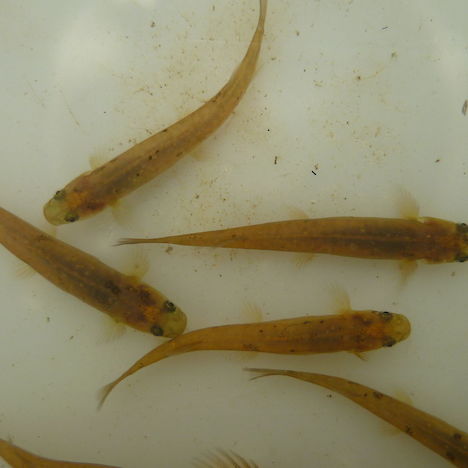Threat category:
Threatened: Nationally Vulnerable?Regions:
OtagoDistribution:
Otago, at mid to high altitudes.
Species Description
- Olive-grey to golden brown body with dark-brown camouflage markings over entire body.
- A slender fish with a distinctly flattened head and a pointy nose.
- Can be difficult to distinguish from some of the other galaxiids that appear to be restricted to the Taieri catchment and takes some practice to identify it accurately.
Interesting Facts
- Flathead galaxias prefer cobble/boulder streams in tussock grasslands, and most populations occur above large waterfalls. They are found at altitudes of 140-1130 m and can live in steep mountain streams.
- This species is presently known from streams in the Taieri catchment and the Shag, Waikouaiti and some coastal streams south of the Taieri. Its fragemented distribution may be a consequence of predation by the introduced brown trout.
- Feed on small stream invertebrates such as mayflies and stoneflies
- This species does not carry out lifecycle migrations.
- Galaxiids are fish lacking scales; the dorsal fin is located very close to the tail.
- Some indigenous fish species are widespread but in low numbers and declining, e.g. longfin eel, giant kokopu, koaro and inanga.
- River species require good riparian cover, streamside shade and logs and/or boulders instream.
- Some indigenous fish species are widespread but in low numbers and declining, e.g. longfin eel, shortjaw kokopu, giant kokopu and lamprey.
Association with Plantations
- All indigenous fish can occur in, or move through, plantation forestry areas.
- Plantation streams and lakes often have relatively high populations of indigenous fish.
Threats
- Destruction of riparian vegetation.
- Competition and predation from introduced fish species.
- Habitat destruction from:
- Modification of riparian margins.
- Introduction of aquatic weeds.
- Siltation.
- Eutrophication (high nutrients).
- Erosion of banks through grazing by livestock, goats and deer.
- Artificial barriers to upstream migration (e.g. culverts, fords with large lips creating a drop off).
- Depleted flows caused by water abstraction.
Management Options and Methods
- Maintain corridors of riparian vegetation along banks. Corridors should be as extensive as possible (refer to Buxton 1991).
- If possible, expand width of riparian zones during later rotation planting.
- Exclude livestock from riparian areas.
- Control deer and goats that could enter riparian areas.
- Comply with best forest operational management practices to avoid damage to riparian areas.
- Provide adequate fish passage through any artificial barriers within streams, e.g. building up downstream side of culverts with Gabion baskets of boulders or using other designs (refer Buxton 1991, Jowett 1999).
- Manage or prevent water abstraction from critical habitat areas.
- Regulate or prevent fishing of threatened species.
- Prevent introductions of exotic fish.
- Prevent introductions of aquatic weeds. Educate local users of weed threats and how to prevent spread.
Monitoring Options
- Undertake surveys to identify fisheries values and species.
- Consider repeating fish surveys every few years to ascertain whether key species are still present.
- Liaise with DOC about fish survey and monitoring methods.
- Report findings to DOC.
- Periodic checks of banks to ensure compliance with best forest operational management practices, pest and weed levels and siltation.
Further Information and Support
- DOC – advice for management, survey, and monitoring. Website http://www.doc.govt.nz/
- Buxton 1991. New Zealand’s wetlands: a management guide. Wellington, Department of Conservation.
- Jowett I. et al. 1999. Fish passage at culverts: a review with possible solutions for New Zealand indigenous species.
- McDowall R.M. 2000. The Reed Guide to Freshwater Fishes.
- NIWA website, Atlas of New Zealand freshwater fishes. Contains detailed identification guides and location maps. http://www.niwa.cri.nz/rc/freshwater/fishatlas


